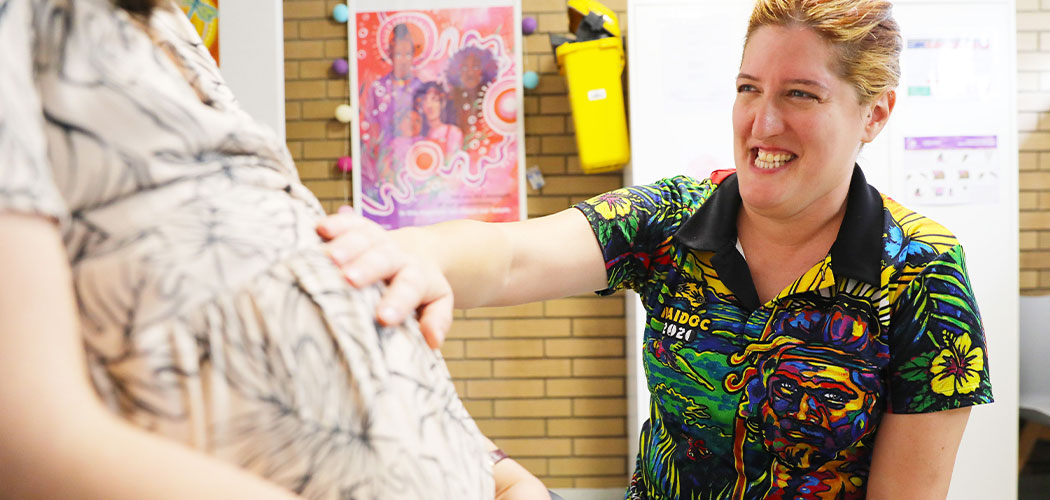Sydney’s Westmead Hospital initiated Midwifery Group Practice (MGP)/caseload care, a decade ago, providing pregnant women with continuity of midwifery care.
This gold-standard maternity care involves a team of midwives ensuring consistent care throughout pregnancy, birth, and the postnatal period. The demand for this model has grown, highlighting its effectiveness and satisfaction for both midwives and women.
“We started with six midwives, and the demand from women [to access the model], and also midwives [to work in the model], has continued to increase,” says Midwifery Unit Manager Carolyn Hilsabeck, who oversees the hospital’s range of midwifery-led models of care, which also include a Maternity Antenatal Postnatal Service (MAPS), and home birth.
As midwife-led models of care have expanded at Westmead, so has the recognition that certain groups could benefit more than others from targeted care. With improving maternity care for First Nations women and babies linked to Closing the Gap, Carolyn says the midwifery unit, supported by the Western Sydney Local Health District, established Dragonfly Midwifery, providing MGP/continuity of care for Aboriginal and Torres Strait Islander women and babies.
The model, which began running in late 2021, includes direct access to a known midwife, pregnancy check-ups, support through labour and birth, and care for up to six weeks postnatally.
Currently, four midwives, including two Indigenous midwives, lead the program, which supports about 80 births annually, with midwives allocated around 25-30 women per year, ensuring that their often complex medical and social needs can be met.
Carolyn says women aren’t automatically allocated into Dragonfly and can choose to access the model of care if they believe it might suit their needs. She reveals that many women are cautious at the beginning but quickly become comfortable once they get to know and trust midwives.
Broad evidence shows that continuity of midwifery care leads to better outcomes for women and babies. For example, a 2016 Cochrane systemic review of research into midwife-led continuity models versus others for childbearing women, found women who received midwife-led continuity models of care were less likely to experience intervention, experienced fewer preterm births and neonatal deaths, and were more likely to be satisfied with their care.
Westmead’s ongoing evaluation of Dragonfly echoes the findings, including a reduction in the preterm birth rate and low birth rate since the program was established. Women have also reported feeling more culturally safe being cared for by a known midwife they can trust.
Indigenous midwife Ngaire Denton, who has worked in Aboriginal health throughout her nursing/midwifery career, joined the close-knit Dragonfly team for two years.
“My biggest driving force [for coming on board] was if you look at the Closing the Gap targets in terms of changing health outcomes for Aboriginal people if you are going to be serious about making a difference, then it needs to start from preconception and pregnancy care,” says Ngaire.
While it isn’t a requirement to be Indigenous to work in the Dragonfly program, Ngaire suggests that it adds an extra layer of trust to the relationship.
“Anything that’s Indigenous-led is going to be more successful because we understand the issues first-hand. It’s really quite empowering for the women as well.”
While Dragonfly is still working towards creating a bigger presence within the community, and among midwives, Ngaire believes it is making a practical, frontline difference.
“My motivations come from a place of just wanting to see better for my people, and I really believe that starts from preconception and pregnancy care,” she says.
As Dragonfly spreads its wings, Carolyn says it continues improving and adding services. For example, a relationship has been established with a local radiology service that bulk-bills pregnant women. Tapping into the hospital’s fundraising arms, the program can also help women financially by supporting them in purchasing prenatal vitamins, for example, or food.
Having worked at Westmead as a midwife for over three decades, Carolyn has seen the growth and acceptance of midwife-led models of care, such as MGP, across the profession. However, there’s still a long way to go to ensure all women have access to such models.
“You have to have the support of the executive,” she says.
“Our Deputy Director of Nursing is on board and willing to take risks and expand the model. What I see from other services who often ring me and ask me for advice is that unless you’ve got someone who understands continuity of care and the benefits of it, it’s not going to get anywhere.”








